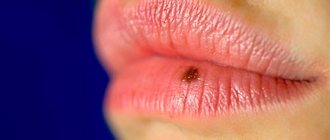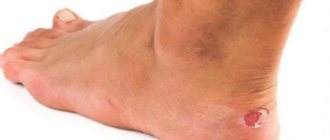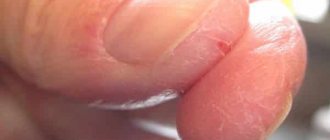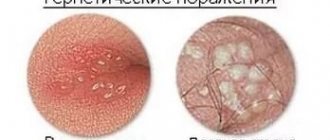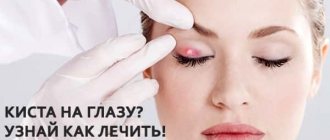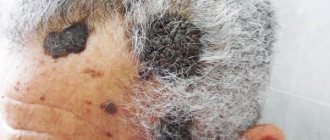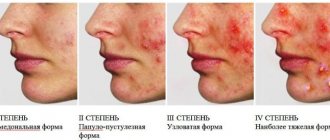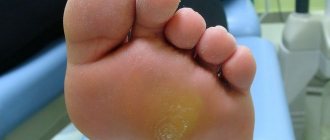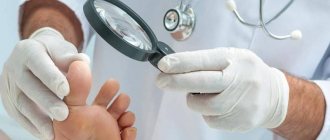So-called “wet” calluses are a very common problem. They can appear quite quickly, all you have to do is, for example, walk a little in new shoes. But for them to heal, it will take much more time, especially since it is most often not possible to leave the damaged area of skin absolutely alone until complete recovery. Therefore, it will be much more effective to facilitate this process, but always correctly, in order to prevent the resulting wound from becoming infected.
Description
A callus with blood is a compacted surface layer of epithelial tissue filled with lymphatic exudate. The amount of blood in the substance depends on how badly the capillaries located in the skin are damaged. If the blood vessels are significantly injured, blood abundantly fills the internal space of the callus.
Blood blisters are more likely to form on the feet:
- on the top of the fingers;
- in the interdigital space;
- on the heels;
- at the bottom of the foot, on the front part bordering the toes.
When performing labor-intensive mechanical work with hand tools, a bloody callus may form on the upper limbs:
- on the inner surface of the palms;
- on the fingers.
Mechanical impact
The appearance of neoplasms is caused by a number of factors. But the most important of them is the mechanical effect (friction or pressure) on an area of thick skin. The type of future callus will depend on its duration and intensity.
If the skin is squeezed or rubbed with little force, then a dry formation will most likely appear on it. This type of callus on the foot is often called a corn. It differs from others in its large size and uneven edges.
A wet or bloody callus appears when friction or pressure on an area of skin has been intense.
Causes
Several factors lead to the appearance of blood calluses:
- active rubbing of the skin in one place;
- sweaty feet;
- wearing uncomfortable shoes;
- neglect of hygiene procedures;
- vitamin A deficiency;
- fungal infections affecting the feet;
- diabetes.
Uncomfortable shoes are the main cause of bloody calluses on your toes, heels and feet.
Rough seams, straps, fasteners and other accessories damage the skin. The skin of the feet is especially vulnerable in hot weather and excessive sweating. High-heeled shoes lead to blisters . In women, the toes are most affected. In high-heeled shoes or sandals, the load is distributed unevenly, with most of it falling on the front of the feet.
In shoes with a closed heel, blisters with blood form in the heel area. The non-standard anatomical structure of the foot leads to calluses. With poorly developed subcutaneous fat tissue, the fingers touch and rub against each other when moving, which leads to the formation of calluses.
It is necessary to carefully approach the choice of shoes. Buy only those pairs that do not cause discomfort during trying on.
What are bloody calluses
The callus itself is a small ball that has formed in the thickness of exfoliated skin and is filled with lymph or blood. Such a bubble causes significant discomfort - it causes pain when exposed. And since the bubble is located at the point of pressure, it creates a lot of inconvenience and can burst at any moment.
Bloody calluses are cavities in the skin that arise as a result of prolonged systematic pressure . Lymph and blood accumulate inside, which gets there from compressed capillaries.
Such formations have a longer recovery time, they cause significant discomfort and can cause an inflammatory process.
Violation of the integrity of the bloody callus is painful, to say the least. A tear in the skin causes the contents to leak out and also creates favorable conditions for bacteria to enter the cavity of the bladder. Since blood vessels extend into the bloody growth, there is a risk of infection spreading throughout the body .
Important! You should not take hot baths with a bloody callus - this may cause increased bruising.
Professional treatment
Calluses on the palms or feet cause pain and discomfort. An infection enters the wound through the opened blister. The damaged area becomes inflamed.
Doctors do not recommend opening blisters on your own. If the blister bursts, you need to disinfect the wound. The skin cannot be removed; it protects the surface of damaged tissues from infection. Blisters that have turned into dry formations are removed with a laser or liquid nitrogen.
Laser removal
Removing calluses with a laser beam is a safe and painless procedure. The patient is given local anesthesia before removal of the formation .
The laser beam burns out the blister in a matter of minutes. The damaged epithelium is cauterized by powerful radiation. The bleeding stops instantly and the wound is disinfected.
After removing the callus, the doctor treats the lesion with an antiseptic and makes a bandage using sterile napkins and a bandage. The laser leaves no traces on the skin - scars or pigment spots.
To prevent the wound from becoming inflamed, the patient must regularly treat the damaged skin using antiseptic solutions.
Elimination with nitrogen
Freezing calluses with liquid nitrogen is an effective procedure. Tissues destroyed by extreme cold become necrotic and flake off. Excessively low temperatures disinfect the wound surface and destroy pathogenic microorganisms. At the site of damage, healthy epithelial tissue quickly grows.
After the procedure, there are no cosmetic defects left - scars and pigmentation.
Treatment of damaged skin
For this purpose, you should first of all use an antiseptic, for example, a solution of furatsilin or hydrogen peroxide. A solution of potassium permanganate has a similar effect, from which you can prepare a bath that helps both disinfect and dry the callus. The procedure time is 5-10 minutes, and the solution itself should not be too concentrated to avoid burns.
Allowing the wound to heal on its own is one of the existing methods to cure such skin damage. To do this, just keep it clean and let it breathe freely. But what if it is in a place where it is difficult to avoid constant friction and pressure? In this case, you cannot do without a patch or sterile bandage. Before applying them, the skin at the site of injury should be washed and treated. Both the bandage and the patch must be changed periodically, repeating the treatment with a regular antiseptic or a special ointment containing antibiotics, for example, tetracycline or erythromycin.
Pharmacy products
Minor calluses are treated with various medications:
- disinfectants - hydrogen peroxide, tea tree oil, potassium permanganate solution;
- patches - Compid, H Dr.House;
- creams - Bepanten, Rescuer, Zinc paste, Erythromycin ointment.
Plasters
For treatment, 2 types of patches are used:
- ordinary;
- special.
A circle matching the diameter of the blister is cut out of an adhesive plaster and glued to the damaged area. Apply ointment to the blister and cover the lesion with a solid sticker.
A special patch is more convenient and more effective than regular adhesive tape. The product is securely attached to the skin, accelerates the healing of damaged epithelium, and protects against infection from penetrating into the wound.
Such products are equipped with a hydrocolloid pad and a ring with a bactericidal composition. The active substance dries, disinfects, relieves pain, itching and inflammation.
To combat calluses use:
- Salipod;
- Compeed;
- Cosmos;
- Urgo;
- House.
Ointments, creams
Paste-like medications help treat calluses . Ointments and creams are used for 7 days. To remove chafing use:
- Salicylic ointment;
- Bensalitin ointment;
- Levomycetin;
- Karavaev balm;
- Levomekol;
- Cream Doctor;
- callus fluid.
Ointments and creams soften keratinized epithelium, suppress pathogenic microflora, dry, accelerate the regeneration of damaged tissues, stop the development of complications, and cleanse the wound of pyogenic exudate. Under the influence of drugs, dry formations soften and peel off. Wet calluses dry out and heal.
How to break in tight shoes at home
I would like to immediately note that you can wear shoes that slightly anatomically do not correspond to the shape of the foot. But this does not apply to shoes or boots that are one size smaller. In addition, products made from genuine leather are easy to stretch, whereas leatherette does not have the necessary elasticity.
Here's how to break in tight shoes at home:
- Moisten the inside with vodka or cologne and walk around the house in it for several hours.
- Winter boots or boots can be worn by wearing them on a thick woolen sock. This will compress the fur a little and make them looser.
- Shoes made of hard leather need to be left in the steam for a while.
- The leatherette is stretched by stuffing with wet newspapers. You just need to make sure that they do not become deformed.
- If the shoes have not been worn in for several days and continue to injure your feet, then discard them. Purchases can be returned to the store within 14 days.
This way you will protect your feet from the formation of calluses.
Traditional methods
Traditional medicine quickly gets rid of calluses on the palms and feet. To eliminate formations, steam baths and applications with herbal ingredients are used.
Folk remedies have a bactericidal, wound-healing and anti-inflammatory effect.
Steaming
Baths effectively remove bloody calluses. The procedure is performed if the blister has not opened. Aspirin is added to hot water (1 tablet per 1 liter of liquid).
The feet float in the solution until the liquid cools, usually 15-20 minutes. Steamed skin softens, dead tissue is easily removed with pumice. The damaged area should be treated carefully, without causing pain or causing additional injury. To eliminate callous formation, 1 procedure is not enough.
To completely remove compacted tissue, several sessions are performed.
Celandine juice
The herbal extract effectively treats calluses filled with blood. Celandine juice can be purchased at a pharmacy. The medicine is bottled in convenient bottles with a dispenser. The liquid is dripped onto the lesion without affecting the surrounding healthy tissue.
Raw potatoes
The raw potato pulp is wrapped in a sterile napkin and fixed on the damaged skin. The procedure is done before bedtime. The compress is removed in the morning.
Aloe
Aloe helps cure blood calluses. In the evening, the pulp of the leaf is applied to the injury and secured with a bandage. In the morning the application is removed. The callus goes away after a few sessions.
Other
Callous formations heal quickly:
- Compresses with table or sea salt. Prepare a 10% salt solution. Before going to bed, a napkin soaked in liquid is applied to the lesion, secured with a bandage, and left until the morning.
- Moisten blood calluses with alcohol tincture of propolis. The drug stimulates metabolism in epithelial tissues and accelerates healing.
- Soap baths. Laundry soap shavings and tea soda are mixed in a ratio of 1:3. Take 4 tablespoons of the mixture and dissolve in 2 liters of warm water.
- Salt baths. For 1 liter of hot water take 5 g of table or sea salt. The solution dries, disinfects and stops the inflammatory process.
Foot baths are done 2-3 times a week. The temperature of the healing solution is 38-40 ℃. The duration of the procedure is 15-20 minutes.
Possible complications
It is possible that complications may arise after self-piercing a blister. The main sign of the development of infection is an increase in body temperature, a general deterioration in health, and the release of purulent impurities. After some time, redness, swelling and severe pain may occur. There is often a possibility of hyperemia near the growth, the appearance of fever, and loss of appetite. These are features of lymphangitis - infection of the lymphatic system. The disease is expressed in the fact that the leg swells and the foot has enlarged lymph nodes.
If such signs are observed, you should urgently consult a doctor.
If calluses are not treated promptly, there is a risk of blood poisoning. This is a fatal pathology.
Preventing abrasions
In order for blood calluses to stop bothering you, you must follow preventive measures:
- Buy shoes according to your foot size. You should only wear a pair that is comfortable, does not pinch, does not constrict your fingers and does not rub your skin. Shoes made from natural, soft, breathable materials are ideal. In summer, you should wear open models without rough elements and accessories.
- Care for shoes: wash and disinfect.
- Perform hygiene procedures, especially in hot weather. Wash your feet, do baths and massages, clean off rough skin with pumice, apply special cosmetic creams.
- Use talc, anti-callus insoles and plasters.
- Choose the right socks. A pair of wrong-sized feet made from synthetic materials increases the risk of blisters.
- Treat fungal infections promptly . With these pathologies, calluses are not uncommon.
Prevention of occurrence
To prevent water heel growth from forming again, it is enough to follow a number of tips:
- Follow the correct recommendations when choosing shoes (exact size, required heel height or instep).
- For preventive purposes, apply patches to areas that are subject to friction.
- Sports shoes should only be worn with socks to avoid chafing.
- Regular hygiene and surface treatment with special products.
- Walk barefoot so your skin can breathe.
- The foot will be protected from calluses if you wear special silicone pads.
A sore callus requires proper care, which includes wearing adhesive tape and limiting friction. If you treat a hard growth correctly, it will soon go away.
The article has been verified by the editors
Features of neoplasms
In appearance, the neoplasms resemble a swollen top layer of skin. There is liquid inside them. These neoplasms are characterized by fairly dense epithelium . Their sizes can be varied.
The appearance of neoplasms of various sizes can be observed against the background of the same provoking factor. Between themselves, blisters can vary in color depending on the reasons for their appearance.
They may be slightly red or white-yellow in color.
In some cases, the neoplasms are surrounded by a ring that is darker in color. Sometimes several neoplasms merge into one bubble. When tumors appear, most patients experience itching and pain in the legs.
